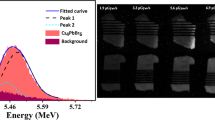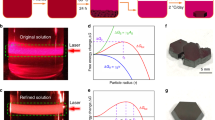Abstract
Halide perovskite semiconductors are poised to revitalize the field of ionizing radiation detection as they have done to solar photovoltaics. We show that all-inorganic perovskite CsPbBr3 devices resolve 137Cs 662-keV γ-rays with 1.4% energy resolution, as well as other X- and γ-rays with energies ranging from tens of keV to over 1 MeV in ambipolar sensing and unipolar hole-only sensing modes with crystal volumes of 6.65 mm3 and 297 mm3, respectively. We report the scale-up of CsPbBr3 ingots to up to 1.5 inches in diameter with an excellent hole mobility–lifetime product of 8 × 10−3 cm2 V−1 and a long hole lifetime of up to 296 μs. CsPbBr3 detectors demonstrate a wide temperature region from ~2 °C to ~70 °C for stable operation. Detectors protected with suitable encapsulants show a uniform response for over 18 months. Consequently, we identify perovskite CsPbBr3 semiconductor as an exceptional candidate for new-generation high-energy γ-ray detection.
This is a preview of subscription content, access via your institution
Access options
Access Nature and 54 other Nature Portfolio journals
Get Nature+, our best-value online-access subscription
$29.99 / 30 days
cancel any time
Subscribe to this journal
Receive 12 print issues and online access
$209.00 per year
only $17.42 per issue
Buy this article
- Purchase on Springer Link
- Instant access to full article PDF
Prices may be subject to local taxes which are calculated during checkout





Similar content being viewed by others
Data availability
The data that support the plots within this paper and other findings of this study are available from the corresponding author upon reasonable request.
References
Kim, Y. C. et al. Printable organometallic perovskite enables large-area, low-dose X-ray imaging. Nature 550, 87–91 (2017).
Xia, J., Zhu, Y. & He, Z. Efficient temperature corrections for gamma-ray energy reconstruction in 3-D position-sensitive CdZnTe detectors. Nucl. Instrum. Methods Phys. Res. A 954, 161340 (2018).
Owens, A. Semiconductor materials and radiation detection. J. Synchrotron Radiat. 13, 143–150 (2006).
Wang, G. et al. Crystal growth and detector performance of large size high-purity Ge crystals. Mater. Sci. Semicond. Process. 39, 54–60 (2015).
Chung, I., Lee, B., He, J., Chang, R. P. H. & Kanatzidis, M. G. All-solid-state dye-sensitized solar cells with high efficiency. Nature 485, 486–489 (2012).
Lee, M. M., Teuscher, J., Miyasaka, T., Murakami, T. N. & Snaith, H. J. Efficient hybrid solar cells based on meso-superstructured organometal halide perovskites. Science 338, 643–647 (2012).
Stoumpos, C. C., Malliakas, C. D. & Kanatzidis, M. G. Semiconducting tin and lead iodide perovskites with organic cations: phase transitions, high mobilities and near-infrared photoluminescent properties. Inorg. Chem. 52, 9019–9038 (2013).
Wang, N. et al. Perovskite light-emitting diodes based on solution-processed self-organized multiple quantum wells. Nat. Photon. 10, 699–704 (2016).
Xing, G. et al. Low-temperature solution-processed wavelength-tunable perovskites for lasing. Nat. Mater. 13, 476–480 (2014).
Xing, G. et al. Long-range balanced electron- and hole-transport lengths in organic–inorganic CH3NH3PbI3. Science 342, 344–347 (2013).
Stoumpos, C. C. et al. Crystal growth of the perovskite semiconductor CsPbBr3: a new material for high-energy radiation detection. Cryst. Growth Des. 13, 2722–2727 (2013).
He, Y. et al. Resolving the energy of γ-ray photons with MAPbI3 single crystals. ACS Photonics 5, 4132–4138 (2018).
Yakunin, S. et al. Detection of gamma photons using solution-grown single crystals of hybrid lead halide perovskites. Nat. Photon. 10, 585–589 (2016).
Wei, H. et al. Dopant compensation in alloyed CH3NH3PbBr3 − xClx perovskite single crystals for gamma-ray spectroscopy. Nat. Mater. 16, 826–833 (2017).
Wei, H. & Huang, J. Halide lead perovskites for ionizing radiation detection. Nat. Commun. 10, 1066 (2019).
McCoy, J. J. et al. Overcoming mobility lifetime product limitations in vertical Bridgman production of cadmium zinc telluride detectors. J. Electron. Mater. 48, 4226–4234 (2019).
Knoll, G. F. in Radiation Detection and Measurement 4th edn 415 (Wiley, 2010).
He, Y. et al. High spectral resolution of gamma-rays at room temperature by perovskite CsPbBr3 single crystals. Nat. Commun. 9, 1609 (2018).
Brenner, T. M., Egger, D. A., Kronik, L., Hodes, G. & Cahen, D. Hybrid organic–inorganic perovskites: low-cost semiconductors with intriguing charge-transport properties. Nat. Rev. Mater. 1, 15007 (2016).
Kovalenko, M. V., Protesescu, L. & Bodnarchuk, M. I. Properties and potential optoelectronic applications of lead halide perovskite nanocrystals. Science 358, 745–750 (2017).
Wei, H. et al. Sensitive X-ray detectors made of methylammonium lead tribromide perovskite single crystals. Nat. Photon. 10, 333–339 (2016).
Nazarenko, O., Yakunin, S., Morad, V., Cherniukh, I. & Kovalenko, M. V. Single crystals of caesium formamidinium lead halide perovskites: solution growth and gamma dosimetry. NPG Asia Mater. 9, e373 (2017).
He, Y. et al. Perovskite CsPbBr3 single crystal detector for alpha-particle spectroscopy. Nucl. Instrum. Methods Phys. Res. A 922, 217–221 (2019).
Dirin, D. N., Cherniukh, I., Yakunin, S., Shynkarenko, Y. & Kovalenko, M. V. Solution-grown CsPbBr3 perovskite single crystals for photon detection. Chem. Mater. 28, 8470–8474 (2016).
Jung, H. S. & Park, N.-G. Perovskite solar cells: from materials to devices. Small 11, 10–25 (2015).
Ke, W., Stoumpos, C. C. & Kanatzidis, M. G. ‘Unleaded’ perovskites: status quo and future prospects of tin-based perovskite solar cells. Adv. Mater. 0, 1803230 (2018).
Ke, W. et al. Efficient planar perovskite solar cells using room-temperature vacuum-processed C60 electron selective layers. J. Mater. Chem. A 3, 17971–17976 (2015).
He, Z., Knoll, G. F., Wehe, D. K. & Miyamoto, J. Position-sensitive single carrier CdZnTe detectors. Nucl. Instrum. Methods Phys. Res. A 388, 180–185 (1997).
Chen, Z., Zhu, Y. & He, Z. Intrinsic photopeak efficiency measurement and simulation for pixelated CdZnTe detector. Nucl. Instrum. Methods Phys. Res. A 980, 164501 (2020).
Zhong, H. Review of the Shockley–Ramo theorem and its application in semiconductor gamma-ray detectors. Nucl. Instrum. Methods Phys. Res. A 463, 250–267 (2001).
Shockley, W. Currents to conductors induced by a moving point charge. J. Appl. Phys. 9, 635–636 (1938).
Ramo, S. Currents induced by electron motion. Proc. IRE 27, 584–585 (1939).
Barrett, H. H., Eskin, J. D. & Barber, H. B. Charge transport in arrays of semiconductor gamma-ray detectors. Phys. Rev. Lett. 75, 156–159 (1995).
Schlesinger, T. E. et al. Cadmium zinc telluride and its use as a nuclear radiation detector material. Mater. Sci. Eng. R Rep. 32, 103–189 (2001).
Sellin, P. J., Davies, A. W., Lohstroh, A., Ozsan, M. E. & Parkin, J. Drift mobility and mobility-lifetime products in CdTe:Cl grown by the travelling heater method. IEEE Trans. Nucl. Sci. 52, 3074–3078 (2005).
Yaffe, O. et al. Local polar fluctuations in lead halide perovskite crystals. Phys. Rev. Lett. 118, 136001 (2017).
Lan, Y. et al. Ultrafast correlated charge and lattice motion in a hybrid metal halide perovskite. Sci. Adv. 5, eaaw5558 (2019).
Miyata, K. et al. Large polarons in lead halide perovskites. Sci. Adv. 3, e1701217 (2017).
Shockley, W. & Queisser, H. J. Detailed balance limit of efficiency of p–n junction solar cells. J. Appl. Phys. 32, 510–519 (1961).
Harrison, M. J., McGregor, D. S. & Doty, F. P. Fano factor and nonuniformities affecting charge transport in semiconductors. Phys. Rev. B 77, 195207 (2008).
Dickey, M. D. et al. Eutectic gallium-indium (EGaIn): a liquid metal alloy for the formation of stable structures in microchannels at room temperature. Adv. Funct. Mater. 18, 1097–1104 (2008).
He, Y. et al. Defect antiperovskite compounds Hg3Q2I2 (Q = S, Se, and Te) for room-temperature hard radiation detection. J. Am. Chem. Soc. 139, 7939–7951 (2017).
Shah, K. S., Lund, J. C., Olschner, F., Moy, L. & Squillante, M. R. Thallium bromide radiation detectors. IEEE Trans. Nucl. Sci. 36, 199–202 (1989).
Li, W., He, Z., Knoll, G. E., Wehe, D. K. & Stahle, C. M. Spatial variation of energy resolution in 3-D position sensitive CZT gamma-ray spectrometers. In 1998 IEEE Nuclear Science Symposium and Medical Imaging Conference (cat. no. 98CH36255) Vol. 621, 628–633 (IEEE, 1998).
Acknowledgements
This work was supported by the Department of Energy, National Nuclear Security Administration, Office of Defense Nuclear Nonproliferation Research and Development under contract no. DE-AC02-06CH11357 (Argonne National Laboratory). The project or effort depicted was sponsored in part by the Department of the Defense, Defense Threat Reduction Agency under award HDTRA1-20-2-0002. The content of the information does not necessarily reflect the position or the policy of the federal government, and no official endorsement should be inferred.
Author information
Authors and Affiliations
Contributions
M.G.K. and Y.H. conceived the experiments. Y.H. and D.Y.C. synthesized, characterized and grew the single crystals. Y.H. fabricated the devices and characterized detector performance. I.H., W.K. and D.G.C. helped to evaporate the electrodes. M.P., C.L. and Z.H. performed the pixelated detector characterization at the University of Michigan. Z.L. and B.W.W. conducted the weighting potential calculation. I.S. performed the contact angle measurement and analysis. Y.H., Z.L., M.P. and M.G.K. wrote the manuscript. All authors discussed the results and commented on the manuscript.
Corresponding author
Ethics declarations
Competing interests
The authors declare no competing interests.
Additional information
Publisher’s note Springer Nature remains neutral with regard to jurisdictional claims in published maps and institutional affiliations.
Supplementary information
Supplementary Information
Supplementary Figs. 1–27, Tables 1–3, Appendices A and B and references 1–28.
Rights and permissions
About this article
Cite this article
He, Y., Petryk, M., Liu, Z. et al. CsPbBr3 perovskite detectors with 1.4% energy resolution for high-energy γ-rays. Nat. Photonics 15, 36–42 (2021). https://doi.org/10.1038/s41566-020-00727-1
Received:
Accepted:
Published:
Issue Date:
DOI: https://doi.org/10.1038/s41566-020-00727-1
This article is cited by
-
Cation-π interactions enabled water-stable perovskite X-ray flat mini-panel imager
Nature Communications (2024)
-
Heavy-to-light electron transition enabling real-time spectra detection of charged particles by a biocompatible semiconductor
Nature Communications (2024)
-
Real-time single-proton counting with transmissive perovskite nanocrystal scintillators
Nature Materials (2024)
-
Surface-defect-passivation-enabled near-unity charge collection efficiency in bromide-based perovskite gamma-ray spectrum devices
Nature Photonics (2024)
-
Modification of CsPbBr3/p-Si Heterojunction Properties using Gamma Ray Irradiation
Silicon (2024)



